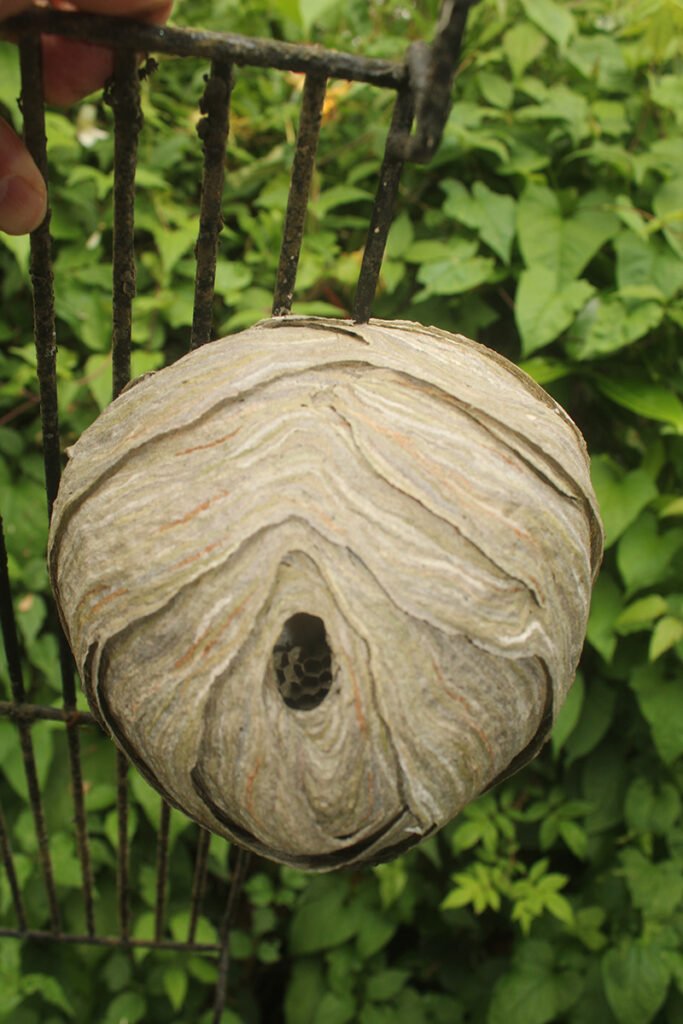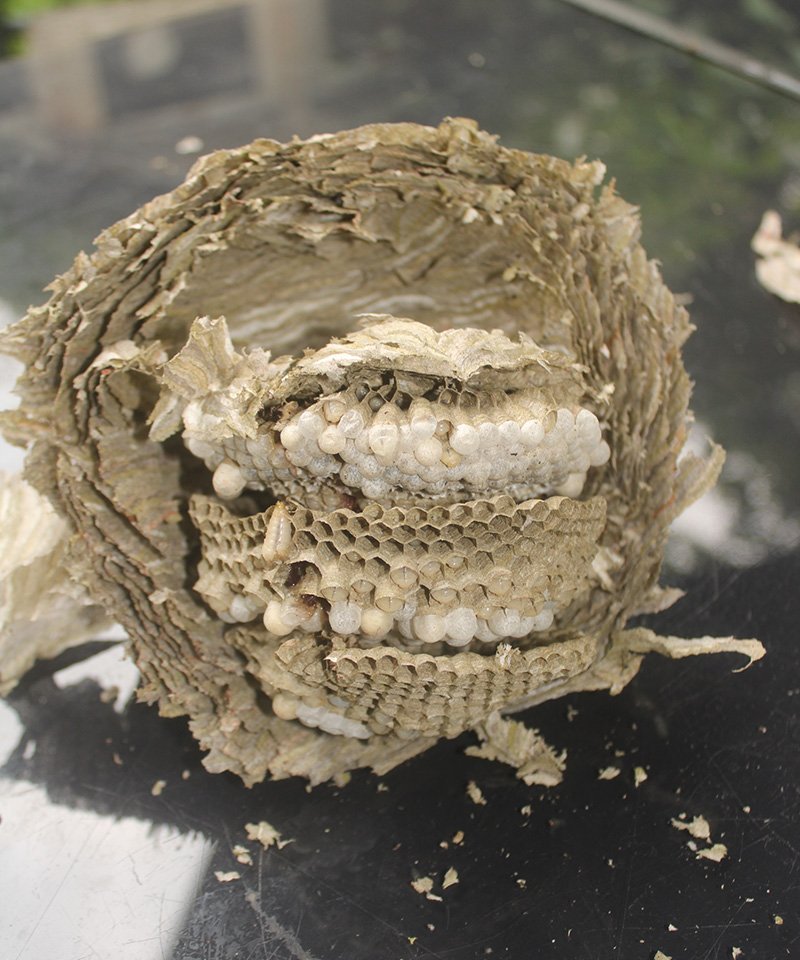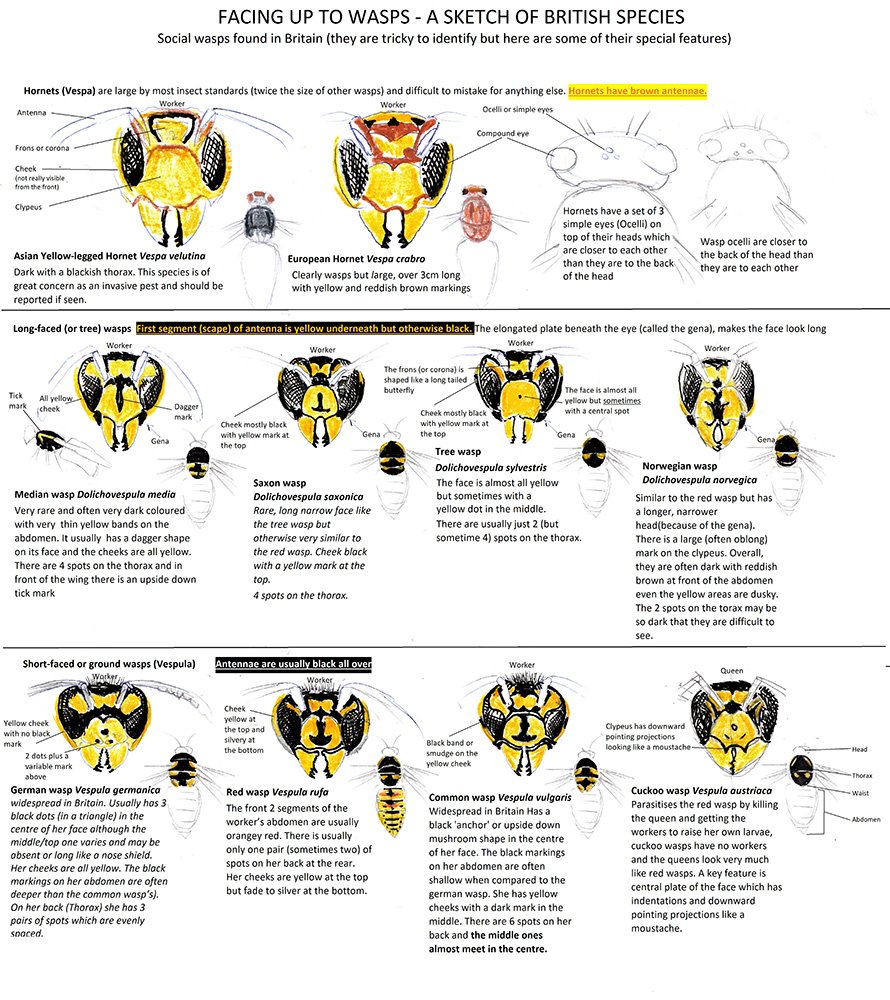Don’t let wasps ruin the end of your summer
Summery weather makes us want to be outdoors but, as the season progresses some of us are pestered or terrorised by little black and yellow beings who seem intent on spoiling our fun. It is all a misunderstanding though, wasps are our allies and they are telling us something about our health.
10 facts about wasps in Britain
Wonderful wasps
- Wasps don’t bite us or suck our blood but they do catch and eat the insects that do bite us. Despite our fear of them, wasps are reluctant to sting and very rarely do.
- Wasps visit many flowers and are very important pollinators.
- Bees are vegetarians (eating pollen and honey). Wasps are omnivorous and are voracious predators of farm and garden ‘pests’. They capture thousands of flies, caterpillars, grubs, aphids and many other invertebrates which they feed to their own larvae.
- Wasps are important prey for badgers, birds, dragonflies and spiders. Badgers love wasp grubs. They often show extreme excitement when they find a nest, darting about and raising their hair like a bottlebrush. They eat adult wasps and their grubs.
- Social wasp colonies are female dominated societies. The single queen is both assisted and controlled by her daughters. They take over from her in defending the nest, foraging for food and caring for young.

The waspy world
There are well over 200 species of wasps found in Britain but most of them are solitary rather than social.
Most social wasps have 3 castes just as bees do:
- the queen who founds the colony and lays all the eggs
- the workers who cannot breed and take on the role of raising young, building and protecting the nest from the queen
- the males (known as drones in honeybee colonies) who do no work.
Adult wasps feed only on nectar and sugary fluids but they feed their young on chewed up insects; thousands of them.
In return for the food they are given, wasp grubs exude a sugary liquid that feeds the workers who care for them. As summer progresses and the grubs become fewer, workers hunt elsewhere for their sugar fix. That’s when they join us on our picnics and outdoor dining experiences.

More things you didn’t know you needed to know about wasps
- There are considered to be 7 resident species of social wasp living in Britain. The largest is the hornet and the most widespread is the common wasp. There are many other species of non-social wasps. Closely related species in North America are known as yellow jackets.
- Wasp nests are made of paper (bee’s honeycomb is made of wax). Wasps collect wood fibres from trees stumps, fence posts and other woody sources. They mix it with their saliva to produce papier mache.
- Despite their intricate construction, wasp nests are usually built in the dark.
- The wasp nest is founded by a single queen in the spring. She builds a nest the size of a ping-pong ball. Her tenderly reared daughters begin to take over from there as they hatch.
- The nest becomes a city (usually hidden away in a hole or a loft). It may reach the size of a human curled up in a ball
- Despite their size, intricacy and the time taken to build them, wasp nests are never re-used. The building process starts afresh with each new queen in a new location.
- A large wasp nest can be home to about 6,000 workers at any one time. They all bring back garden and crop pests to their 10,000+ baby sisters at various stages of development.
- The queen wasp can choose whether to fertilise an egg and produce a worker (or a queen) or leave it unfertilised to produce a male.
- Late in the summer the queen starts aging and produces more male wasps. As she dies, her daughters the workers, feed an enriched diet to some of their remaining younger sisters. They become new queens ready for the following year.
- Once the queen has died and the new queens have flown away, the workers have no brood to feed. So they wander around looking for food which is very much on show with pic-nickers and outdoor diners.
- Wasps (and bumblebees) can sting over and over again if they need to. Honeybees have barbed stingers which cannot be dislodged from mammal skin, so they die as their internal organ are pulled out.
- Whilst honey bee colonies live on and on for years, wasp (and bumblebee) colonies die out each year. New queens are left in the autumn to start new colonies in the spring.
- Queen wasps hibernate with their precious and delicate wings tucked under their bodies. If disturbed in winter, they often look wingless.
- In evolutionary terms, ants are wasps which have given up flying except when breeding.
- Wasp nests come to a tragic end. If they are not dug up by badgers or poisoned by humans, or some similar violent fate, the natural decline of a colony is a sort of social decay.
Towards the end of her life the queen is producing more males and queens and, as old workers die, there are soon not enough to feed the babies who begin to starve. Losing weight, they fall out of their cells and the workers then, seeing them as ‘rubbish’ throw them out of the nest in the tidying up process. Horrifying as this seems, it is great for birds and shrews and hedgehogs who are fattening up for winter. - Worker wasps cannot survive the cold of winter and the food supply, flowers and insects, run out as autumn arrives. Damp weather weakens the paper nest which, without constant care and repair collapses and the wasp season is over.
Waspy worries
If a wasp is pestering you/ if it lands/if you are stung
- Wasps are attracted to the foods which are least healthy for us, sugar and meat. Eat healthier (and less aromatic) food and wasps are less of a problem. The main exception to this is fruit, don’t let us put you off fruit!
- Male wasps can’t sting and have longer antennae than workers and queens. The sting is an adaptation of the egg laying mechanism so only females, (queens and workers) can have one.
- Wasps are alerted to danger by people who flap their arms about. The best way to keep wasps calm is to stay still or move slowly.
- Replacing lids on food and cleaning up spills can significantly reduce wasp visitors to your outdoor dining experience.
- Diversionary tactics can work well. By placing a saucer of honey or some sweet liquid a little way away from where you want to sit in peace, can keep the local wasp population occupied.
- Wasps check out perfume in case it is food in much the same way that dogs like bins. Going perfume free for the late summer saves money and helps avoid conflict with wasps
- Being unafraid of wasps (and bees and spiders) is empowering.
Treat Them Like a Tigress
The best approach to take with wasps is to treat them almost like little tigeresses. Something you would go out of your way to see. They are stripy, colourful, beautiful, fascinating and a little bit exciting. Wasps should be admired as tiny little things that can terrify a grown man.
The season is so short that it’s actually worth making the time to watch them. With a drop of honey or marmalade, they will peacefully take food from your hand.
Once you have overcome your fear (and I was terrified as a child) wasps are enjoyable and people’s behaviour around them can be amusing and fascinating but more often bemusing! I have been asked to remove wasp nests from lofts, bird houses, porches, barbeques and all sorts of other places. Sometimes the wasps landlords relent and agree to leave them in peace, but those I have removed have not stung me despite me handling the nest. My last sting was in 1994 (Boxing day) when I jumped into my wellies in the shed and disturbed a hibernating queen.

What to do if you get stung
Firstly it is worth making sure if you can whether it is a wasp or a honeynee. Honeybees usually leave their sting behind along with the little white venom sack which keeps pumping venom and driving the sting further in. It is important to flick the sting out and not to pinch it as pinching squeezes more venom in.
Then…
Wash the sting
Apply cold water or ice which helps reduce pain
I’ve never used them but after sting creams are available and can be very effective
If you have had reactions to stings before, antiistamines are the thing. The venom contains a cocktail of chemicals (including histamines) which are intended to paralyse prey, but also enzymes which breakdown cell walls to increase penetration and make insects more digestible.
If it becomes more red or painful and you feel other symptoms, seek medical advice.

The Wasp’s Year
Autumn – A Royal birth
A wasps year really begins in the autumn when the queens leave their old colony.
A short and Royal affair – They mate with males from other colonies and find a dry refuge to hibernate. The males die before winter.
A Winter Refuge
Usually the queen will clamp her jaws onto wood fibres or something similar in hollow trees, log piles, sheds or attics and hang there to sleep for about 6 months.
Spring – Founding a Colony
As the weather warms the queen wakes up and finds a suitable place to build her city. She works hard often digging with her jaws to enlarge a cavity in the ground and carrying the soil outside.
Collecting wood fibres that she scrapes from trees, fence posts and similar wooden objects. She mixes the pulp with her saliva to make papier mache and begins to build a little canopy hanging from a paper stalk. Beneath the canopy she sculpts 15 to 20 hexagonal cells which look like honeycomb. The open ends of the paper cells face downwards with the comb being horizontal unlike honey comb which is build vertically and made of wax.

The queen lays an egg in each of the cells and then extends the paper canopy downwards to enclose it in a pod about the size of a ping pong ball. She powers herself on nectar from flowers but, as the eggs hatch into larvae she begins collecting all sorts of insects which she feeds to her daughters individually. She divides her time between feeding, foraging, building new cells and egg laying. Imagine if Buckingham Palace started like this!
Summer – The Work Force Arrives
As the queen extends the central paper stalk and builds a new storey, hanging beneath the original nursery, the babes spin silk lids to their cells and pupate inside. Three or four weeks after the eggs were laid, the wasps emerge. The offspring begin to help the queen who eventually stops foraging and stays in the nest laying eggs. She may produce 25,000 or so offspring in her short life.
With her infertile princesses now feeding the young, extending, repairing and defending the nest, the queen can be even more productive. She begins to produce male heirs (her choice) and the females which the workers will nurture to become new queens like herself.
Late Summer and Autumn
This new fertile generation leaves the nest. The society is breaking down with not enough workers to feed remaining larvae and food becomes more scarce. Wasp workers hunt for sweet food for themselves and are attracted to outdoor diners (ourselves) who have very little time for these hard working, sociable artists and architects.
A Sketch Of Wasps In Britain
Social wasps found in Britain
We often consider the striped beauty who ruins our picnics as just one type of wasp, but there are a number of social wasps in Britain. They are tricky to identify but once you get started, it can make the picnic invasion much more fun.
Here are some of their special features
Hornets (Vespa)
These beasties are large by most insect standards (twice the size of other wasps) and difficult to mistake for anything else. Hornets have brown antennae.
European Hornet Vespa crabro
Clearly wasps but large, over 3cm long with yellow and reddish brown markings rather than black It is Southern species but spreading north. They visit our garden in Wales.
Asian Yellow-legged Hornet Vespa velutina
Darker with a blackish thorax. This species is of great concern as an invasive pest and should be reported if seen.
Short-faced or ground wasps (Vespula)
Antennae are usually black all over
Common wasp Vespula vulgaris
Widespread in Britain (the worker (up to 14mm long) has a black anchor or upside down mushroom shape in the centre of her face. The black markings on her abdomen are shallow when compared to the German wasp. She has yellow cheeks with a dark mark in the middle. There are 6 spots on her back and the middle ones almost meet in the centre.
German wasp Vespula germanica
Widespread in Britain, the worker (up to 16mm long) usually has 3 black dots (in a triangle) in the centre of her face although the middle one varies and may be absent or long like a nose shield. Her cheeks are all yellow. The black markings on her abdomen are often deeper than the common wasp’s). On her back (Thorax) she has 3 pairs of spots which are evenly spaced.
Red wasp Vespula rufa
The front two segments of the worker’s abdomen are usually orangey red – 14mm long.
There is usually only one pair (sometimes two) of spots on her back at the rear. Her cheeks are yellow at the top but fade to silver at the bottom.
Cuckoo wasp Vespula austriaca
This beauty parasitises the red wasp by killing the queen and getting the workers to raise her own larvae. Cuckoo wasps have no workers and the queens look very much like red wasps. A key feature is a central plate of the face which has indentations and downward pointing projections like a moustache.
Long-faced (or tree) wasps
First segment (scape) of antenna is yellow underneath but otherwise black.
Tree wasp Dolichovespula sylvestris
The top of the worker’s head is black and the face is almost all yellow but sometimes with a central black dot. The cheeks are black with a yellow patch at the top.
Norwegian wasp Dolichovespula norvegica
The worker is similar to the red wasp but has a longer, narrower head. They are often dark with reddish brown at front of the abdomen even the yellow areas are dusky
Median wasp Dolichovespula media
Very rare and often very dark coloured with very thin yellow bands on the abdomen. It usually has a dagger shape on its face and the cheeks are all yellow. There are 4 spots on the thorax.
Saxon wasp Dolichovespula saxonica
Rare, long narrow face like the Norwegian wasp but otherwise very similar to the red wasp.
You can grab a FREE copy of the ID guide by clicking here
For more information see: www.bwars.com and www.bigwaspsurvey.org



